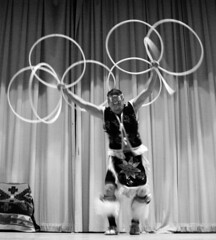Nathan Crites-Herren
The Paw Print
The deep rooted history of oppression and marginalization of the indigenous cultures within this country has left the majority of non-indigenous peoples with an incomplete understanding of the significant contributions made by native peoples. In order to bring attention to this issue, Adams State’s, Autumn at Adams: “Honor Your Story, Discover Your Possibilities,” began their series of Autumn events with members of the Dine and Sioux tribes demonstrating their skills and wisdom in an engaging and interactive presentation.
During the presentation, native cultural history was explored using the avenue of dance, music and audience participation to create an interactive environment that kept the audiences’ attention throughout the two and a half hour program. Robert and Ramona Roach, world redound Pow-Wow champions and native musicians opened the show with a mix of dance, history and music. Happily married, Robert (Sioux) and Ramona (Dine) are school teachers and use their presentation to not only entertain but to educate the audience about the many misconceptions of native culture.
Ramona and Norman began their show by explaining the importance of the dance in indigenous culture. “Natives have two types of dances, those that are sacred and those that are social. In front of the public we do not dance our sacred dances just social dances, and although all our dances are sacred we change them in a way so they become social dances. We use social dances to communicate our history with the larger outside community while still keeping the sacred elements of our dance for the future native generations.”
Symbolism within the dances performed was evident not only in the dance itself, but in the preparation for the dance. For example, the “jingle dress” that Ramona presented while performing the “Lady Buckskin dance,” was entirely quilled and beaded by hand. “This dress took me years to make, the dress making is part of the dance, first you have to see if you are patient enough to create the dress, then you are ready to perform the dance,” said Ramona. The “Lady Buckskin Dance,” is one of the oldest known dances in the Dine tradition, it has been traced back to the mid 1800’s and it honors the man, or father sky.
A definite highlight in the performance came with the “hoop dance” performed by Norman. Coordination and athleticism combined to form a moving art piece as Norman danced with at first two hoops and then eight, making shapes and animal like figures while keeping to the beat of the drum. A truly tiring number, lasting for about seven minutes, the dance was something that took almost six years for Norman to perfect.

Photo by Nathan Crites-Herren: Norman performs the "Hoop Dance"
Norman also took some time to discuss some of the stereotypes associated with indigenous peoples. The Hollywood image of the Native dancing with his hand over his mouth around a giant bon-fire was exposed as a lie. “My people never did that, this was an exaggeration made up by the “Hollywood tribe” that is still used today.” Additionally, he discussed the stereotype of native women being those who do all the physical work while the men are only worried about personal presentation and prestige. Within native society women and men are treated equally, the rise of prescribed gender roles in indigenous communities was a result of the assimilation into settler culture, added Norman.
The second act of the night featured comedian, singer, song writer and recording artist James Bilagody who is a member of the Dine tribe. In contrast with the very traditional presentation given by Norman and Ramona, Bilagody’s approach infused American culture with Native. He used a guitar to play mid 1950’s rock music while relating that music to his experience on the Dine Reservation. Through comedy and music Bilagody taught the audience to understand the importance of always carrying a song in your heart. “Wherever you go and whatever you do always keep a song in your heart, that is what the Navajo teach, because the song is not only ceremony, but it encompasses all of life.”
The central theme of “carrying a song in your heart,” was used to connect to the larger wisdom of native peoples by demonstrating that ceremony and music take participation, which is a key factor in life. “The Native teachings stress inner strength, which is gained from ceremony, music and participation, this helps create the fortitude to deal with the many inconsistences of life,” said Bilagody. Audience participation was expected from Bilagody, teaching the audience key philosophical phrases in the Dine language like, Sa-a-na-le (the search for old age) and Beke-ho-jon (the way of beauty)which helped the audience connect to a central part of the Dine culture, language.
With these key Dine phrases, the audience was directed in a common Dine cultural dance in which Bilagody expressed the importance of the dance as not only a ceremony, but as a tool to understand each other as human beings. “Natives use the dance for everything; it is a form of counseling that brings out deep emotions. That’s why I want to show the audience this-they must experience the dance to feel the power that music has.”
What’s Been Said…